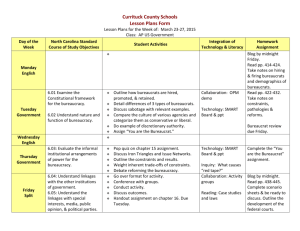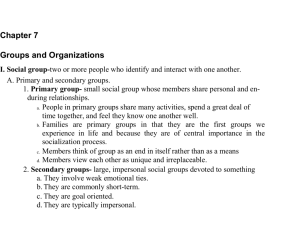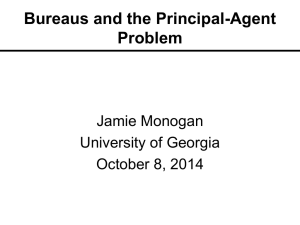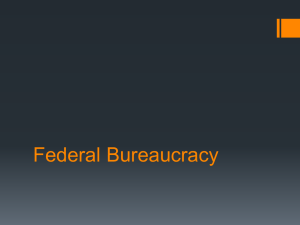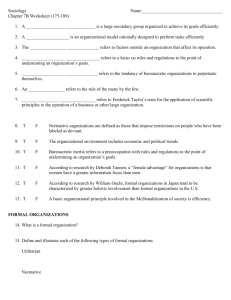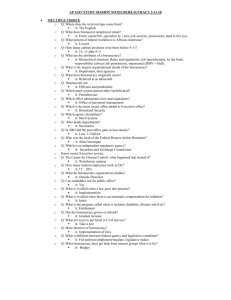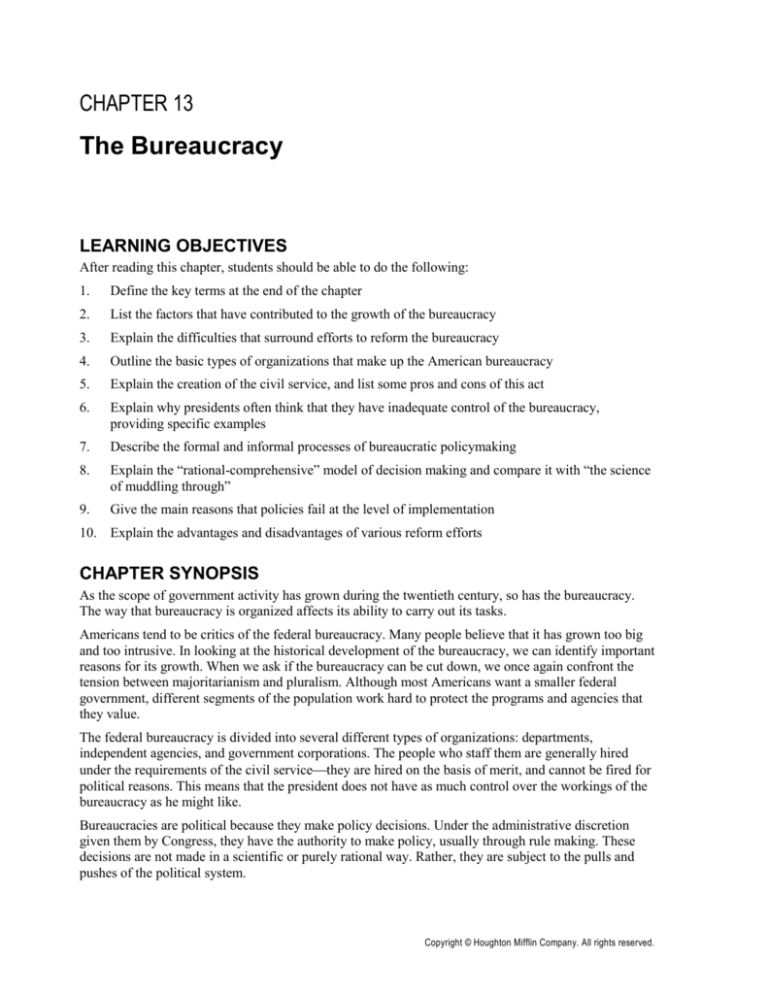
CHAPTER 13
The Bureaucracy
LEARNING OBJECTIVES
After reading this chapter, students should be able to do the following:
1.
Define the key terms at the end of the chapter
2.
List the factors that have contributed to the growth of the bureaucracy
3.
Explain the difficulties that surround efforts to reform the bureaucracy
4.
Outline the basic types of organizations that make up the American bureaucracy
5.
Explain the creation of the civil service, and list some pros and cons of this act
6.
Explain why presidents often think that they have inadequate control of the bureaucracy,
providing specific examples
7.
Describe the formal and informal processes of bureaucratic policymaking
8.
Explain the “rational-comprehensive” model of decision making and compare it with “the science
of muddling through”
9.
Give the main reasons that policies fail at the level of implementation
10. Explain the advantages and disadvantages of various reform efforts
CHAPTER SYNOPSIS
As the scope of government activity has grown during the twentieth century, so has the bureaucracy.
The way that bureaucracy is organized affects its ability to carry out its tasks.
Americans tend to be critics of the federal bureaucracy. Many people believe that it has grown too big
and too intrusive. In looking at the historical development of the bureaucracy, we can identify important
reasons for its growth. When we ask if the bureaucracy can be cut down, we once again confront the
tension between majoritarianism and pluralism. Although most Americans want a smaller federal
government, different segments of the population work hard to protect the programs and agencies that
they value.
The federal bureaucracy is divided into several different types of organizations: departments,
independent agencies, and government corporations. The people who staff them are generally hired
under the requirements of the civil servicethey are hired on the basis of merit, and cannot be fired for
political reasons. This means that the president does not have as much control over the workings of the
bureaucracy as he might like.
Bureaucracies are political because they make policy decisions. Under the administrative discretion
given them by Congress, they have the authority to make policy, usually through rule making. These
decisions are not made in a scientific or purely rational way. Rather, they are subject to the pulls and
pushes of the political system.
Copyright © Houghton Mifflin Company. All rights reserved.
Chapter 13: The Bureaucracy
147
Bureaucrats must implement policiesput the ideas on paper into action. This is difficult for many
reasons: vague directives from Congress means it isn’t clear what should be done; administrative
limitations and lack of discretion on the front lines can make it hard to make a good idea work.
It seems easier to catalog the failings of bureaucracy than to find cures for them. One wave of reform
efforts focused on deregulation as a means to reduce the size of government while reforming the
bureaucracy by diminishing its role over the marketplace. Other approaches have required bureaucrats
to set and meet performance standards, and have encouraged bureaucrats to compete with private
business. All these approaches raise important questions. Who are an agency’s “customers” in a
pluralistic system where there are so many different types of individuals and groups involved? Who
should bear the brunt of the risks that are associated with deregulation? And what happens when we
begin to value what can be done over what needs to be done?
PARALLEL LECTURE 13.1
I.
II.
Organization matters
A. Bureaucracies: large, complex organizations in which employees have specific job
responsibilities and work within a hierarchy of authority.
1. Bureaucrats: the employees of these government units.
2. Bureaucracies play a central role in the governments of modern societies
B. The manner in which a bureaucracy is organized affects how well it is able to accomplish its
tasks.
C. The purpose of studying the bureaucracy centers on finding solutions to the many kinds of
problems faced by large government organizations.
The development of the bureaucratic state
A. The growth of the bureaucratic state
1. Government at all levels grew enormously during the twentieth century.
2. Reasons for growth:
a) Increasing complexity of society
b) Public’s attitude toward business changed at the end of the nineteenth century
c) Attitudes about government’s responsibilities for social welfare have changed.
d) Ambitious, entrepreneurial agency officials have expanded their organizations to
take on added responsibilities.
B. Can we reduce the size of government?
1. Americans want smaller government that costs less and performs better.
a) Bureaucracies would have to be eliminated or reduced in size.
b) Serious budget cuts require serious program reductions.
c) Presidents and Congress face opposition when they try to cut specific programs.
d) Government often turns former bureaucrats’ jobs to nonprofit or private
contractors.
2. Serious efforts to contract bureaucracy have varied considerably.
a) Reagan made an effort to reduce domestic social programs, but had only modest
success.
b) Clinton wanted to expand the role of government through health care reform, but
was frustrated by Republican congresses.
c) Budget deficit continues to rise under George W. Bush, making it unlikely
government will provide services for the needy
3. Creation of new agencies masks evolutionary changes in the bureaucracy
4. Tendency for big government to endure reflects tension between majoritarianism and
pluralism
a) Public as a whole wants smaller government
Copyright © Houghton Mifflin Company. All rights reserved.
148
Chapter 13: The Bureaucracy
b)
Different segments of society have strong desire for government to continue
performing a specific function.
III. Bureaus and bureaucrats
A. The organization of government
1. Department: the biggest unit of the executive branch, covering a broad area of
government responsibility; the heads of the departments, or secretaries, form the
president’s cabinet.
2. Independent agency: an executive agency that is not part of a cabinet department.
a) Some are controlled by the White House (e.g., the CIA)
b) Some are structured as regulatory commissions: an agency of the executive
branch of government that controls or directs some aspect of the economy (e.g.,
the FCC).
3. Government corporations: government agencies that perform services that might be
provided by the private sector but that involve either insufficient financial incentive or
are better provided when they are somehow linked with government (e.g., the postal
service).
B. The civil service
1. American national bureaucracy has 2.9 million civilian employees (2 percent of the
U.S. workforce)
2. Most are hired under the requirements of the civil service
a) Civil service: the system by which most appointments to the federal bureaucracy
are made, to ensure that government jobs are filled on the basis of merit and that
employees are not fired for political reasons.
b) Established by the Pendleton Act (1883)
3. Criticism of federal bureaucracy has raised concerns about recruiting qualified
personnel, but no evidence of decline
C. Presidential control over the bureaucracy
1. Presidents appoint fewer than 1 percent of all executive branch employees.
a) Presidential appointments fill top policymaking positions.
b) Candidates tend to be drawn from business, universities, and government.
2. Presidents often feel that they have insufficient control over the bureaucracy.
3. Reasons for bureaucratic unresponsiveness to the president
a) Pluralism pulls agencies in directions other than that favored by the president.
b) Bureaucrats must follow the laws governing the programs they are entrusted
with.
4. Bureaucratic policy does generally, if slowly, move in the direction set by the White
House.
a) Presidents appoint administrators sympathetic to their policy goals.
b) Aides review agency policymaking to ensure it is in line with president’s goals.
5. Congress may amend laws to override regulations.
a) When the president faces a Congress controlled by the opposing party, this is
more significant.
b) White House and agency administrators have incentive to consult with committee
chairs to minimize conflict
c) Committees can cut an agency’s budget, alter a key program, or hold up
confirmation of nominees (Senate only).
6. Different presidents pay different amounts of attention to the details of policymaking.
IV. Administrative policymaking: the formal processes
A. Administrative discretion
1. Congress creates cabinet departments, independent agencies, and government
corporations.
Copyright © Houghton Mifflin Company. All rights reserved.
Chapter 13: The Bureaucracy
a)
b)
V.
149
Grants agencies authority to make certain policy decisions
Administrative discretion: the latitude that Congress gives agencies to make
policy in the spirit of their legislative mandate.
2. Critics of bureaucracy frequently complain that agencies are granted too much
discretion.
a) Congress is often vague about its intent when setting up a new agency or
program.
b) Bureaucrats work out the details.
3. Broadest discretion is grant to those agencies involved in domestic and global security
(FBI, CIA)
B. Rule making
1. Rule making: the administrative process that results in the issuance of regulations by
government agencies.
2. Regulations: administrative rules that guide the operation of a government program.
a) Regulations have the force of law.
b) Regulations are first published as proposals so that all interested parties have an
opportunity to comment.
c) Regulations are controversial, because they force people and businesses to act in
certain prescribed ways, often against their own self-interest.
Administrative policymaking: informal politics
A. The science of muddling through
1. “The Science of Muddling Through” by Charles Lindblom
a) Highlighted the difficulties bureaucracies have in trying to reach rational
decisions
b) Rational-comprehensive model: administrators can rank values, clarify
objectives, explore all possible solutions, and choose the most effective means to
the desired goal.
c) Real-world decision making does not meet these criteria.
(1) It is difficult to precisely define values and goals; they may conflict.
(2) Politically, it may not be possible to select the most effective means to the
desired ends.
(3) Problems are often too pressing to wait for a complete study.
2. Policymaking tends to be characterized by incrementalism: policymaking
characterized by a series of decisions, each instituting modest change.
B. The culture of bureaucracy
1. Interactions with bureaucrats may be frustrating.
a) They may be inflexible (going by the book).
b) They may lack authority.
2. Modern bureaucracies develop rules and standards to make operations efficient and
guarantee fair client treatment.
3. Norms: an organization’s informal, unwritten rules that guide individual behavior.
a) Also influence the way people act on the job
b) IRS norms used to encourage an adversarial relationship with taxpayers (changed
after 1997)
c) Reinventing Government initiative created new norms in government.
d) Emphasized listening to customer, teamwork, breaking down organization
barriers, and participatory management
e) Norms and an agency’s sense of mission often influence selection of policy
options.
4. Administrators may override prevailing patterns of behavior to please the White House
and Congress.
Copyright © Houghton Mifflin Company. All rights reserved.
150
Chapter 13: The Bureaucracy
Bureaucrats “go by the book” because “the book” is actually the laws they administer
and are required to enforce.
a) Regulations are often broad standards intended to cover a range of behavior.
b) Sometimes regulations don’t seem to make sense—equal application of the law
doesn’t take exceptions into account.
c) It would be unsettling if bureaucrats interpreted rules on a case-by-case basis.
VI. Problems in implementing policy
A. Implementation: the process of putting specific policies into operation.
B. Factors that make implementation difficult
1. The policy is not clearly stated; policy directives may lack clarity and leave
bureaucrats with too much discretion.
2. The complexity of some endeavors (e.g., Superfund clean-up; responding to Katrina)
C. Patience and continual analysis are necessary ingredients of successful policymaking.
D. Implementation is an incremental process.
VII. Reforming the bureaucracy: more control or less?
A. Three basic approaches to reforming bureaucracy
1. Deregulation
2. Competition
3. Performance Standards
B. Deregulation
1. Regulation: Government intervention in the workings of a business market to promote
some socially desired goal.
2. Deregulation: a bureaucratic reform by which the government reduces its role as a
regulator of business.
a) Championed by conservatives who see freedom in the marketplace as the best
route to an efficient and growing economy
b) Considerable deregulation took place in the 1970s and 1980s (airline, trucking,
financial services, and telecommunication)
3. Deregulation particularly difficult for health and safety issues
a) Companies may make legitimate claim that health and safety regulations are
burdensome.
b) Deregulation may pose significant danger (e.g., thalidomide case).
c) But drugs of great benefit may be kept from the market for years.
4. Reflects traditional dilemma of freedom versus order
C. Competition and outsourcing
1. Reformers advocate that unless bureaucracies can demonstrate they are as efficient as
the private sector, their functions should be turned over to the private sector.
2. Most widespread adaptation of competitive bidding to administer government
programs: social services
a) Provision of social services is labor intensive
b) Outsourcing has historically gone to nonprofit organizations such as community
health centers and elderly day care centers.
c) For-profit companies have begun to compete for grants and contracts.
3. Competition and outsourcing: procedures that allow private contractors to bid for
jobs previously held exclusively by government employees.
a) Bush administration has mounted extensive effort to bring competition and
outsourcing to national government
b) New regulations adopted in 2003
c) Government agencies will compete with the private sector to keep providing
services.
5.
Copyright © Houghton Mifflin Company. All rights reserved.
Chapter 13: The Bureaucracy
D.
151
Performance standards
1. Congressional and White House overseers examine each agency to see if it meets its
objectives, and reward or punish accordingly.
2. Government Performance and Results Act of 1993: law requiring each government
agency to implement quantifiable standards to measure its performance in meeting
stated program goals.
a) Requires agencies to publish reports with performance data on each measure
b) Under President G.W. Bush:
(1) Office of Management and Budget surveys individual programs and rates
them “effective,” “adequate,” or “ineffective”
(2) Administration provides quarterly ratings of each cabinet department and
major agency
3. Problems with performance management
a) Agencies may set goals and indicators where they know they will do best.
b) May tend to focus on what can be achieved rather than what would be most
valuable to achieve
INTERACTIVE MEDIA LECTURE 13.1—THIS IS BUREAUCRACY?
The Alien Bureaucracy of Independence Day
The bureaucracy is actually very visible in the popular media, though the word is rarely used. Every
“government agent,” every police officer, every teacher, every doctor and nurse working in a public
hospital is a bureaucrat. Use this film clip to begin a discussion of the various functions of bureaucracy,
and to stimulate discussion about the purpose of government activity—particularly when that activity
has no clear or direct benefit.
Independence Day (1996) is the story of the United States (and the world) under attack—by
extraterrestrial beings. The aliens unleash powerful weapons that destroy most of the world’s major
cities. Thrown into chaos, a group of scrappy Americans—including a computer genius (played by Jeff
Goldblum), a jet pilot (Will Smith), and the president (Bill Pullman)—band together to save the planet.
They are led into the famed “Area 51” in Nevada, where the “alien bureaucracy,” led by Dr. Brakish
Okun (Brent Spiner), is the focus of this film clip.
Film clip: Independence Day begin at DVD Ch. 37 (tape 1:14:00)
Run to 1:20:34 (approximately 6 minutes); if you have more time, run to 1:32:45 (almost 19 minutes).
The longer clip provides several vivid examples of the bureaucratic endeavor and the tension between
the military and the bureaucracy.
I.
II.
The Nature of bureaucracy
A. Define bureaucracy.
B. Discuss the President’s relationship to the federal bureaucracy.
C. What types of bureaucrats are visible in this clip? (Be sure to differentiate between the
bureaucracy and the military.)
D. Discuss the president’s attitude toward the bureaucrats in this film.
1. Is that attitude plausible?
2. Why or why not?
The bureaucratic endeavor
A. What is the nature of the work these bureaucrats do?
B. Despite the fictional nature of the film, how is that work like the work of real bureaucrats?
(possible comparisons: NIH, NASA)
Copyright © Houghton Mifflin Company. All rights reserved.
152
Chapter 13: The Bureaucracy
C. If the Area 51 project was real, would this be a justifiable government expenditure?
D. Why might it be difficult to justify continuing a project such as this?
III. Perceptions of bureaucracy
A. What are some of the stereotypes people have about bureaucracy?
B. What are some of the stereotypes about bureaucracy that are visible in this clip?
IV. Bureaucratic reform
A. What are the three major types of bureaucratic reform?
B. If the Area 51 project was subject to bureaucratic reform, what would be the best approach
to use? Why?
C. What might be the disadvantages of subjecting a project like this to any type of reform?
V. The reality and fiction of bureaucracy
A. What is most plausible about the portrayal of bureaucracy in this clip?
B. What is least plausible about the portrayal of bureaucracy in this clip?
C. Independence Day suggests to us that not all government activity is visible to the public.
Should this be allowed—and under what conditions?
FOCUS LECTURE 13.1—AN INTERACTIVE LECTURE
Your Students and Government Regulation
The objective of this interactive lecture is to help students understand the numerous ways that
government regulation affects their lives, both positively and negatively. Your goal is to bring the
material into focus at the students’ current level of experience and to build on their current knowledge
with your own expertise. The lecture relies on “individual brainstorming,” in which students make lists
on their own sheet of paper in response to the topics you present. Brainstorming techniques mean that
there is no censorship, no judgment, and no evaluation. Explain to them that the idea is to let ideas flow
freely and then sort them out, categorize them, and evaluate their merit.
I.
Ask the class to begin brainstorming by making individual lists on the following concepts:
A. Government rules that affect business
B. Government rules that affect consumers
C. Government rules that affect students
II. If you find students are having a hard time, you can prime the pump either by referring them to
their textbook for ideas or by mentioning the following examples:
A. Regulation of television, utilities, nuclear power, and milk and other food products
B. Regulation of banking, the stock exchange, food and drugs, and health and safety standards
at work
C. Regulations of scholarships, federal loans and grants, and admission policies (such as
affirmative action or equal opportunity)
III. While students are working, you can circulate, giving encouragement and offering “pump
primers.” You can also divide your chalkboard into three areas: business, consumer, and student.
IV. Give students five to ten minutes to make their lists of regulations, and then ask for volunteers to
write one of their items on the board under the appropriate heading. Students will enjoy watching
for overlaps with their own lists. Then expand the chalkboard areas, adding data you generate by
asking the following questions:
A. Who knows which level of government has created which regulations? (Do your best to help
them sort out federal, state, and local regulations as needed.)
B. Who knows which agencies have created which regulations? (Let them use their texts for
reference, and help them as best you can to identify the agencies responsible for specific
regulations.)
Copyright © Houghton Mifflin Company. All rights reserved.
Chapter 13: The Bureaucracy
153
C.
V.
Optional: Offer extra credit for research to follow up on information that no one knows,
such as the agency responsible for your college’s loan application procedures.
Move the dialogue into the area of evaluation.
A. Ask students to comment on which regulations seem least useful or least valuable to society.
B. Ask students to comment on which regulations seem most useful or most valuable to society.
C. Develop a dialogue that analyzes differing student opinions.
1. What role do students’ personal experiences play in their attitudes about particular
forms of regulation?
2. What role do students’ backgrounds (ethnic, socioeconomic, and so on) play in their
attitudes about particular forms of regulation?
PROJECTS, ACTIVITIES, AND SMALL-GROUP ACTIVITIES
1.
What is regulation? The best way to find out is to sit down and read some regulations. They are
easily accessible at the library (all a student has to do is to open up any copy of the Federal
Register) or on the Internet (see the list of Internet Resources). Students should be instructed to
read the narrative portion that precedes the actual regulations and then to read a few paragraphs of
the regulations themselves. They should read the narrative to try to get the gist of what the agency
is attempting to accomplish through its regulations.
2.
How do government agencies change over time? Students can look up information about the
creation of an agency and record the functions and programs originally assigned to it. They can
then collect similar information for the same agency (or its successor, if there has been a
significant reorganization) as it exists now. What new functions and programs has the agency
acquired over the years? What led to those additions? If it is an agency that actually died or whose
functions have largely disappeared through reorganization, what led to its demise?
3.
We all believe that some part of government is wasteful—that it administers programs that aren’t
needed or that are unduly generous to some group of individuals. But what one segment of society
finds wasteful may be a vital program of assistance to another. Farm subsidies, for example, are
perceived rather differently by farmers than by city dwellers, and educational grants are perceived
differently by non-college graduates than by those who have gone (or are going) to college.
Students can choose one program they think is valuable and another program they think is
wasteful. After doing a modest amount of research on what the two programs actually do, they
can make arguments in the form of a short written assignment or class presentation.
4.
Use the idea of citizens as “customers” to do a role-playing activity that suggests the multiple
pressures that bureaucrats face. Provide students with some background on a specific federal
agency or program (your choice, but some interesting possibilities include the IRS, the student
loan program, public assistance, the EPA, and NASA). Now ask students to list who this agency
or program’s “customers” are: help them brainstorm all the professional, bureaucratic, citizen
groupsand citizens in generalthat must be satisfied. Now ask one student to play a
representative of that organization, while other students assume these various rolesand make
demands on the “bureaucrat.” The bureaucrat must attempt to respond to each of their demands,
within the bounds set by the program or agency, of course. How are bureaucrats to satisfy all of
these various constituencies? If that isn’t possible, who should be their first priority? What should
they do if the needs of one type of “customer” directly conflict with the needs of another? Close
the exercise with a discussion of how government as a service provider faces different challenges
than private service providers faceand how this makes “reform” particularly difficult.
Copyright © Houghton Mifflin Company. All rights reserved.
154
Chapter 13: The Bureaucracy
INTERNET RESOURCES
The Cabinet and Executive Departments www.whitehouse.gov/government/
A listing of all of the departments in the executive branch with links to their Web pages
Federal Register www.gpoaccess.gov/fr/index.html
Read agency rules and notices of rule making online.
Fedworld www.fedworld.gov/
This site is a clearinghouse for U.S. government information on the Web. Learn about federal
employment opportunities and follow links to various department home pages.
Federal Energy Regulatory Commission www.ferc.gov/
Find out more about the process of government regulation of the price and distribution of natural
gas, oil, and other sources of energy.
Copyright © Houghton Mifflin Company. All rights reserved.



